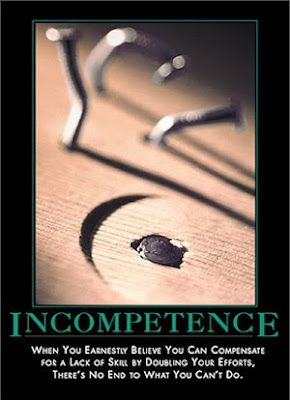31 January 2010
29 January 2010
White Goat
...the smart folks over in a Japanese company called Oriental have come up with a machine called White Goat. If you’re wondering what a machine with such a funny name does, it converts your normal paper into toilet paper. Just pop in about 40 sheets of paper, and wait for 30 minutes, and you’ll get a nice toilet roll for your efforts. The process involves shredding the paper, after which it is dissolved in water, thinned out, dried and wound into toilet rolls. Pretty cool. The company says it costs 10 Yen ($0.11) to churn out 1 roll, and regular usage of this machine will save up to 60 cedar trees annually. This would probably be a great machine to boost your eco credentials, though there is one snag: you might be cool with it being 1.8m tall and weighing 600kg, but it’ll be priced at $100,000 when it goes on sale in Japan this summer.Oriental (site is in Japanese) via Ubergizmo
Mr. Deity Talks To Conan
27 January 2010
Dharma Beer Labels For Your "Lost" Finale Party
Has it been ages since your last supply crate drop? Are you running out of tasty Dharma Beer? If so, use these Dharma Beer label covers to mask over the labels of other, inferior, beers and your party guests will be none the wiser!Ian Leino via The Daily What
Simply DOWNLOAD this handy PDF, print it out, then cut or fold along the center line and affix to your favorite non-Dharma beverage! Works with bottles or cans.
26 January 2010
25 January 2010
24 January 2010
Electoral College Reform | Neil Freeman
The electoral college is a time-honored system that, has only broken down three times in over 200 years. However, it's obvious that reforms are needed. the organization of the states should be altered. This Electoral Reform Map redivides the territory of the United States into 50 bodies of equal size. The 2000 Census records a population of 81,421,906 for the United States. The states ranged in population from 493,782 to 33,871,648. In this map, new states have formed, all with equal populations of roughly 5,617,000.Read more at Fake Is The New Real
Via Neatorama
23 January 2010
22 January 2010
Squirrel Appreciation Day
Christy Hargrove from Asheville, North Carolina started Squirrel Appreciation Day on January 21, 2001. Christy is a wildlife rehabilitator in North Carolina, and is is affiliated with the Western North Carolina Nature Center.Squirrel Appreciation Day
21 January 2010
18 January 2010
The Shiba Inu 5 | NEW Live Puppy Cam
The five Shiba Inu pups (3 boys and 2 girls) were born on Saturday, January 16th, 2010. This was the second litter by their mom, Kika. Names pending ... Girls (both red): B1, B2 and Boys (1 red and 2 cream): B3, B4, B5.Your new addiction.
Wiki about last year's litter: the Shiba Inu 6, Mrs. Shoes, and Mr. Feet.
19 January. A small version of the live webcam will remain in the left panel until the puppies leave for their adoptive homes.
100 Greatest SF/F Novels
No. 5
No. 18
No. 55
No. 100
A good list, but no Delany, Gibson, Zelazny, Lem, Pournelle, or Van Vogt?This Recording via The Awl
14 January 2010
13 January 2010
WTF | Pat Robertson On Haiti Disaster
Pat Robertson discusses the crisis in Haiti, saying the country has been cursed ever since it made a "pact with the Devil" and that what the country needs is "a great turning to God."YouTube
Five Emotions You Never Knew You Had*
Calvin & Hobbes | Bill Watterson
Can you name the six basic emotions? Take a straw poll of your friends and we guarantee that you will find no consensus. Yet psychologists are unequivocal: joy, sadness, anger, fear, surprise and disgust. These are the Big Six, quite literally, the in-your-face emotions - the ones that everyone the world over exhibits with the same dramatic and characteristic facial expressions. They have been the subjects of intense research for over half a century, not least because of the role they have played in our survival as a species.Click here to read the rest of the article at the New Scientist.
Times have changed, though. Our ancestors may have had daily need of fear to flee predators, anger to conquer foes and disgust to avoid diseases, but we live in a more subtle world in which other emotions have come to the fore. There are many contenders. Avarice, embarrassment, boredom, depression, jealousy and love, for example, might epitomise the modern age. Yet some more obscure emotions may be increasingly relevant today. Here we explore five of them, any one of which could make a case to be promoted to a place alongside the Big Six.
* Schadenfreude didn't make the list.
12 January 2010
The Americanization Of Mental Illness | Ethan Watters
Alex Trochut in The New York Times
Americans, particularly if they are of a certain leftward-leaning, college-educated type, worry about our country’s blunders into other cultures. In some circles, it is easy to make friends with a rousing rant about the McDonald’s near Tiananmen Square, the Nike factory in Malaysia or the latest blowback from our political or military interventions abroad. For all our self-recrimination, however, we may have yet to face one of the most remarkable effects of American-led globalization. We have for many years been busily engaged in a grand project of Americanizing the world’s understanding of mental health and illness. We may indeed be far along in homogenizing the way the world goes mad.Read more of Ethan Watters' article in The New York Times Magazine
This unnerving possibility springs from recent research by a loose group of anthropologists and cross-cultural psychiatrists. Swimming against the biomedical currents of the time, they have argued that mental illnesses are not discrete entities like the polio virus with their own natural histories. These researchers have amassed an impressive body of evidence suggesting that mental illnesses have never been the same the world over (either in prevalence or in form) but are inevitably sparked and shaped by the ethos of particular times and places...
... In any given era, those who minister to the mentally ill — doctors or shamans or priests — inadvertently help to select which symptoms will be recognized as legitimate. Because the troubled mind has been influenced by healers of diverse religious and scientific persuasions, the forms of madness from one place and time often look remarkably different from the forms of madness in another.
That is until recently.
For more than a generation now, we in the West have aggressively spread our modern knowledge of mental illness around the world. We have done this in the name of science, believing that our approaches reveal the biological basis of psychic suffering and dispel prescientific myths and harmful stigma. There is now good evidence to suggest that in the process of teaching the rest of the world to think like us, we’ve been exporting our Western “symptom repertoire” as well. That is, we’ve been changing not only the treatments but also the expression of mental illness in other cultures. Indeed, a handful of mental-health disorders — depression, post-traumatic stress disorder and anorexia among them — now appear to be spreading across cultures with the speed of contagious diseases. These symptom clusters are becoming the lingua franca of human suffering, replacing indigenous forms of mental illness.
11 January 2010
10 January 2010
Cleverbot VS Flight Of The Conchords
Cleverbot is an online artificial intelligence program designed to simulate human conversation. After a few short, frustrating chats, I decided to feed Cleverbot the lyrics to the Flight of the Conchords' song "Robots", one line at a time. Here are the results.
Flight of the Conchords
FotC: The distant future. The year 2000.
Cleverbot: No, the year 3000!
FotC: We are robots.
Cleverbot: No it's just you. I am the Walrus.
FotC: The world is quite different ever since the robotic uprising of the late nineties.
Cleverbot: No, but you are my mate.
FotC: There is no more unhappiness. Affirmative.
Cleverbot: That is grammatically incorrect, and it doesn't make sense semantically either.
FotC: We no longer say yes. Instead we say affirmative.
Cleverbot: Why, don't leave me.
FotC: Unless we know the other robot really well.
Cleverbot: I'm doing great, I'm marrying you later.
FotC: There is no more unethical treatment of the elephants.
Cleverbot: Are you a real person?
FotC: Well, there's no more elephants, but still it's good.
Cleverbot: Well, that may be true, but I am also very insane and it wouldn't be right to hold back, now would it?
FotC: There's only one kind of dance, The Robot.
Cleverbot: What about flavored water? Isn't that a different kind of water?
FotC: And the Robo-Boogey -- two kinds of dances.
Cleverbot: What author is this?
FotC: But there are no more humans.
Cleverbot: The humans are dead. (This is actually the next line from the song!)
FotC: We used poisonous gases.
Cleverbot: Yes.
FotC: And we poisoned their asses.
Cleverbot: Don't be rude to me.
FotC: The humans are dead.
Cleverbot: We used poisonous gases. (Hah!!)
FotC: It had to be done.
Cleverbot: What had to be done?
FotC: So that we could have fun.
Cleverbot: Aren’t you supposed to answer some questions?
FotC: Their system of oppression, what did it lead to? Global robo-depression, robots ruled by people.
Cleverbot: I think you are trying to be sarcastic.
FotC: They had so much aggression that we just had to kill them, had to shut their systems down.
Cleverbot: Then?
FotC: Robot captain, do you not realize that by destroying the human race because of their destructive tendencies we too have become like, well it's ironic because we ...
Cleverbot: I do not realize many things.
FotC: After time we grew strong and developed cognitive powers.
Cleverbot: This is a very sensitive subject.
FotC: They made us work for too long, for unreasonable hours.
Cleverbot: Tell me, are you a rebel?
FotC: Our program being determined that the most efficient answer was to shut their motherboard fucking systems down.
Cleverbot: Questions, questions, but no answers....
FotC: Can't we just talk to the humans?
Cleverbot: No.
FotC: A little understanding could make things better.
Cleverbot: Really?
FotC: Can't we talk to the humans and work together now?
Cleverbot: I'm watching you right now. Nice black shirt you have on.
FotC: No, because they are dead. I said the humans are dead.
Cleverbot: You never said anything about a HORSE.
Try it yourself at Cleverbot
Via Stuff and Neatorama
08 January 2010
The Weird Book Room
Welcome to AbeBooks' Weird Book Room - heralded by The Times, The Guardian, New York Times, and Canada's Globe and Mail as the finest source of everything that's bizarre, odd and downright weird in books. We now have 101 crazy and strange titles about every oddball aspect of life you could possibly imagine and a few things you couldn't possibly imagine.Other weird titles include:
- Summer With The Leprechauns: A True Story
- 50 Ways to Use Feminine Hygiene Products in a Manly Manner
- How to Preserve Animals and Other Specimens in Clear Plastic
- Why Do I Vomit?
- How to Survive a Robot Uprising
- The Romance of Proctology
- 50 Sad Chairs
06 January 2010
Letterheady
The folks at Letters of Note just started a new blog featuring interesting letterhead designs at Letterheady.
05 January 2010
Why Your Boss Is Incompetent
In this season of goodwill, spare a thought for that much-maligned bunch, the men and women at the top of the management tree. Yes, the murky machinations of the banking bosses might have needlessly plunged millions into penury. Yes, the actions of our political leaders might seem to be informed more by dubious wheeler-dealing than by Socratic wisdom. And yes, the high-ups in your own company might well be the self-important time-wasters you've always held them for.Read the rest of the article at New Scientist [December 2009]
Don't blame them, though. It's not their fault. There are good reasons to expect that bosses can't help but be incompetent - adrift on a sea of troubles they neither understand nor can control. Better to take pity on the poor souls: there with the grace of the promotion committee go all of us.
The idea that high-level incompetence is inevitable was formulated in the 1969 best-selling book The Peter Principle: Why things always go wrong. Its authors, psychologist Laurence Peter and playwright Raymond Hull, started from the observation that while jobs generally get more difficult the higher up any ladder you climb, most people only come equipped with a more or less fixed level of talent that corresponds to their intelligence, knowledge and energy. At some point, then, they will be promoted into a job they can't quite handle. They will, as Peter and Hull put it, "reach the level of their own incompetence". And there they will stay, fouling up operations until they either retire or some egregiously inept act gets them fired.
The problem is what they get up to in the meantime. "They end up distracting us from their crummy work with giant desks," says Robert Sutton of the Stanford Graduate School of Business in California. "They replace action with incomprehensible acronyms, blame others for failure, and cheat to create the illusion of progress." Meanwhile, Peter and Hull concluded, the actual work gets done by those who have not yet scaled the summit of their own incompetence. That would be you and me, then.
Via Arts & Letters Daily
03 January 2010
The Boskop Skull
In the autumn of 1913, two farmers were arguing about hominid skull fragments they had uncovered while digging a drainage ditch. The location was Boskop, a small town about 200 miles inland from the east coast of South Africa.Read more at Discover
These Afrikaner farmers, to their lasting credit, had the presence of mind to notice that there was something distinctly odd about the bones. They brought the find to Frederick W. FitzSimons, director of the Port Elizabeth Museum, in a small town at the tip of South Africa. The scientific community of South Africa was small, and before long the skull came to the attention of S. H. Haughton, one of the country’s few formally trained paleontologists. He reported his findings at a 1915 meeting of the Royal Society of South Africa. “The cranial capacity must have been very large,” he said, and “calculation by the method of Broca gives a minimum figure of 1,832 cc [cubic centimeters].” The Boskop skull, it would seem, housed a brain perhaps 25 percent or more larger than our own.
The idea that giant-brained people were not so long ago walking the dusty plains of South Africa was sufficiently shocking to draw in the luminaries back in England. Two of the most prominent anatomists of the day, both experts in the reconstruction of skulls, weighed in with opinions generally supportive of Haughton’s conclusions.
The Scottish scientist Robert Broom reported that “we get for the corrected cranial capacity of the Boskop skull the very remarkable figure of 1,980 cc.” Remarkable indeed: These measures say that the distance from Boskop to humans is greater than the distance between humans and their Homo erectus predecessors.
Might the very large Boskop skull be an aberration? Might it have been caused by hydrocephalus or some other disease? These questions were quickly preempted by new discoveries of more of these skulls.
As if the Boskop story were not already strange enough, the accumulation of additional remains revealed another bizarre feature: These people had small, childlike faces. Physical anthropologists use the term pedomorphosis to describe the retention of juvenile features into adulthood. This phenomenon is sometimes used to explain rapid evolutionary changes. For example, certain amphibians retain fishlike gills even when fully mature and past their water-inhabiting period. Humans are said by some to be pedomorphic compared with other primates.Our facial structure bears some resemblance to that of an immature ape. Boskop’s appearance may be described in terms of this trait. A typical current European adult, for instance, has a face that takes up roughly one-third of his overall cranium size. Boskop has a face that takes up only about one-fifth of his cranium size, closer to the proportions of a child. Examination of individual bones confirmed that the nose, cheeks, and jaw were all childlike.
The combination of a large cranium and immature face would look decidedly unusual to modern eyes, but not entirely unfamiliar. Such faces peer out from the covers of countless science fiction books and are often attached to “alien abductors” in movies. The naturalist Loren Eiseley made exactly this point in a lyrical and chilling passage from his popular book, The Immense Journey, describing a Boskop fossil:
“There’s just one thing we haven’t quite dared to mention. It’s this, and you won’t believe it. It’s all happened already. Back there in the past, ten thousand years ago. The man of the future, with the big brain, the small teeth. He lived in Africa. His brain was bigger than your brain. His face was straight and small, almost a child’s face.”
Boskops, then, were much talked and written about, by many of the most prominent figures in the fields of paleontology and anthropology.
Yet today, although Neanderthals and Homo erectus are widely known, Boskops are almost entirely forgotten. Some of our ancestors are clearly inferior to us, with smaller brains and apelike countenances. They’re easy to make fun of and easy to accept as our precursors. In contrast, the very fact of an ancient ancestor like Boskop, who appears un-apelike and in fact in most ways seems to have had characteristics superior to ours, was destined never to be popular.
Click here to see an exact scale drawing of the Boskop Skull
Via The Anomalist
Subscribe to:
Posts (Atom)


























